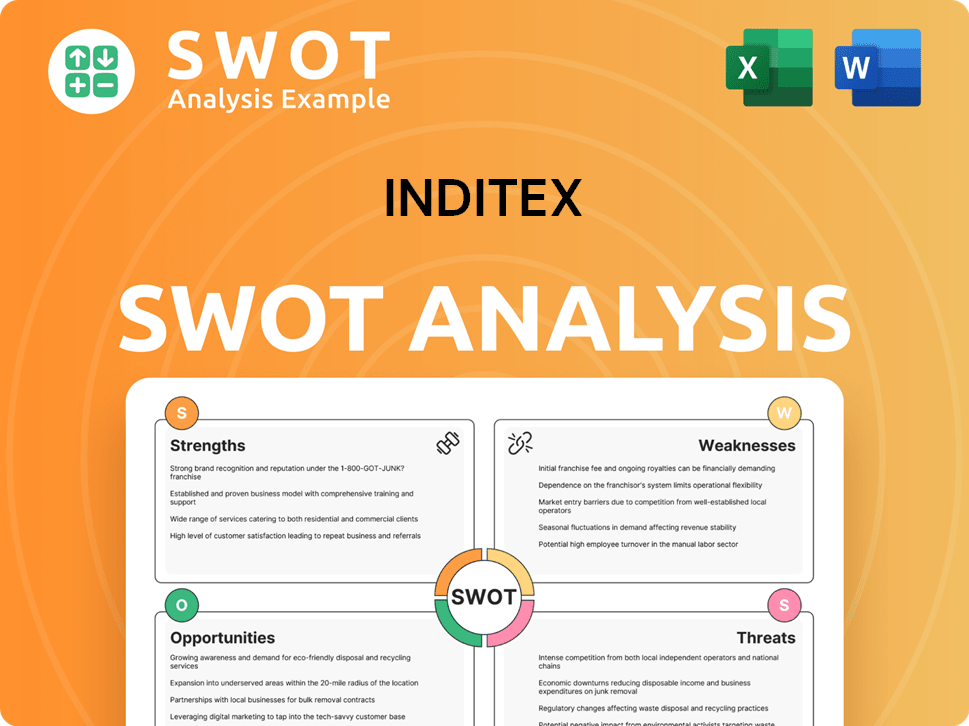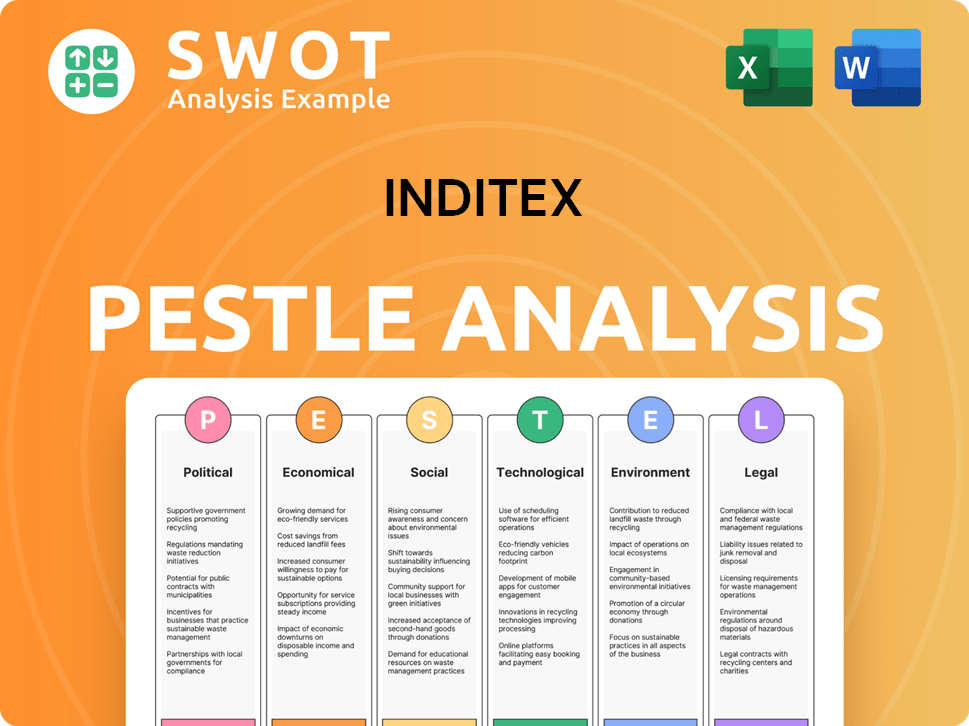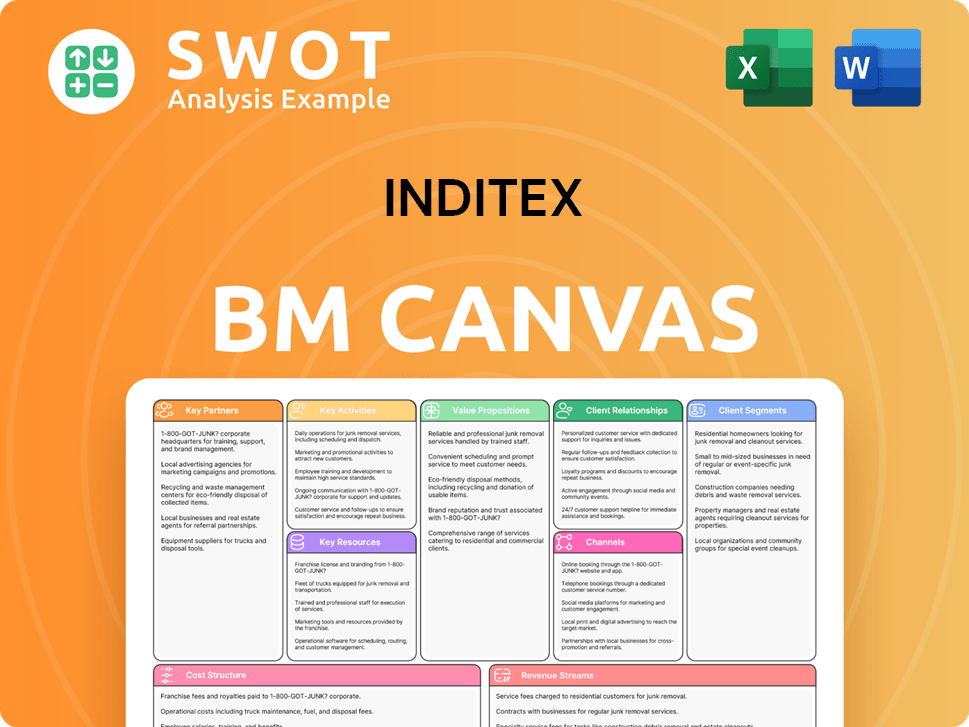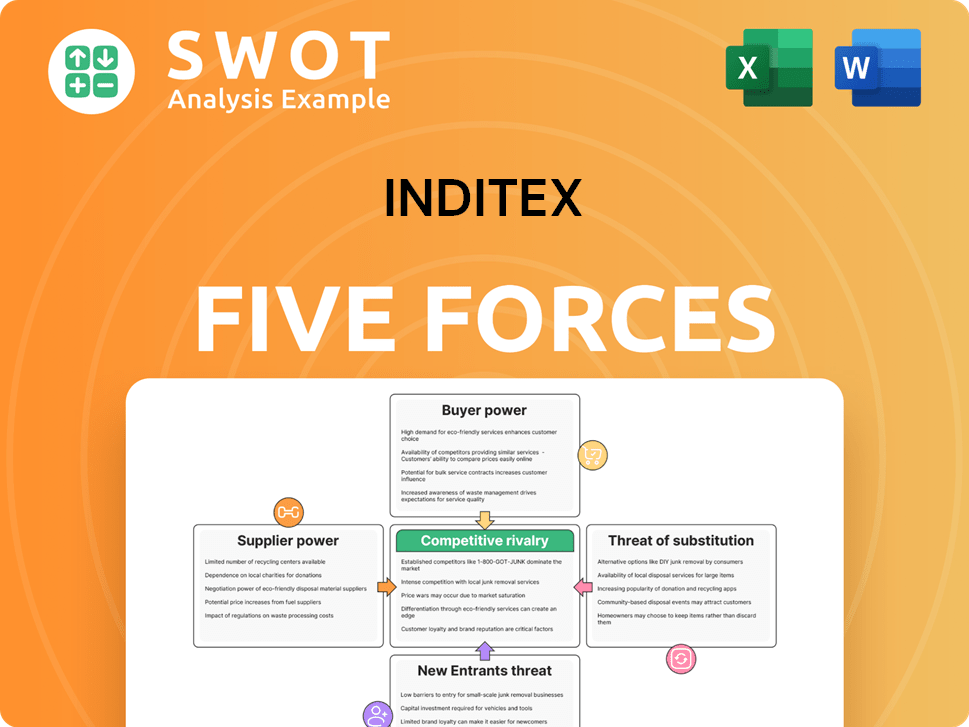Inditex Bundle
How Does Inditex Dominate the Global Fashion Market?
Inditex, the parent company behind Zara and other iconic brands, has reshaped the fashion industry with its innovative Inditex SWOT Analysis and fast-fashion model. Founded in 1975, Inditex swiftly adapted to evolving consumer preferences, transforming from a local retailer into a global powerhouse. This article dives deep into the company's strategies that have propelled it to the forefront of the fashion world.

This exploration of Inditex's success will analyze its dynamic Inditex sales strategy and Inditex marketing strategy, revealing how it maintains its Inditex competitive advantage. We'll examine the company's sophisticated Inditex business model, including its global expansion strategy and customer relationship management, along with Zara marketing tactics and its impact on the fast fashion strategy.
How Does Inditex Reach Its Customers?
The sales and marketing strategy of Inditex revolves around a robust omnichannel approach, designed to provide customers with a seamless shopping experience across various channels. This strategy is a core element of the Inditex business model, ensuring that the company can reach a global customer base effectively. The integration of online and offline channels is a key aspect of the Inditex sales strategy, allowing for efficient inventory management and enhanced customer service.
Inditex's primary sales channels include its extensive network of physical retail stores and its growing e-commerce platforms. The company has strategically invested in both areas to maximize its market reach and adapt to evolving consumer behaviors. This dual approach is a key component of the Inditex marketing strategy, supporting its global expansion strategy and maintaining its competitive advantage in the fast fashion industry.
As of January 31, 2024, Inditex operated a network of 5,692 stores worldwide. These physical stores, particularly Zara's flagship locations, are not just points of sale but also key touchpoints for brand experience and customer engagement, often featuring innovative designs and digital integration. The company's e-commerce platforms, accessible through brand-specific websites and mobile applications, have experienced significant growth.
Inditex's e-commerce platforms, accessible through brand-specific websites and mobile applications, have experienced significant growth. Online sales accounted for 33% of total sales in 2023. The company consistently invests in optimizing its online experience, offering features such as in-store pickup and personalized recommendations.
Inditex's physical retail stores serve as a crucial part of its sales strategy. These stores provide a tangible brand experience and allow for direct customer interaction. The company's brick-and-mortar presence complements its online channels, creating an integrated shopping experience.
The evolution of these channels has seen a strategic pivot towards greater omnichannel integration, where inventory is shared between online and physical stores. This integration enables services like 'Store Mode' in Zara's app, which allows customers to browse in-store inventory and locate items. This approach enhances customer convenience and streamlines operations.
While Inditex primarily operates through its own retail and e-commerce channels, it has also explored strategic partnerships and exclusive distribution deals. These collaborations help expand market reach in specific regions or for certain product categories. These partnerships contribute to sustained growth and market share.
Inditex's sales and marketing efforts are focused on creating a cohesive customer experience. This involves leveraging both online and offline channels to meet customer needs and preferences. The company's approach is data-driven, using insights to optimize its strategies and enhance its competitive advantage.
- Omnichannel Approach: Seamless integration of online and offline channels.
- Digital Investments: Continuous optimization of e-commerce platforms.
- Customer Experience: Prioritizing convenience and personalization.
- Strategic Partnerships: Expanding market reach through collaborations.
For more insights into how Inditex achieves its growth, consider reading about the Growth Strategy of Inditex.
Inditex SWOT Analysis
- Complete SWOT Breakdown
- Fully Customizable
- Editable in Excel & Word
- Professional Formatting
- Investor-Ready Format

What Marketing Tactics Does Inditex Use?
The marketing tactics employed by Inditex are multifaceted, blending digital innovation with traditional methods to enhance brand visibility and drive sales. This approach is crucial for maintaining its position in the fast fashion market. The company's strategy focuses on creating engaging customer experiences across various platforms.
Inditex's approach to marketing is dynamic, adapting to changing consumer behaviors and technological advancements. This flexibility is essential for the company to stay competitive. The company uses a mix of digital and traditional marketing techniques.
Inditex's success in sales and marketing is evident in its global presence and strong financial performance. The company's ability to quickly respond to fashion trends and customer preferences is a key part of its marketing strategy.
Inditex utilizes content marketing through its websites and social media platforms. Search Engine Optimization (SEO) is crucial for driving organic traffic to its e-commerce sites.
The company strategically uses paid digital campaigns, including display ads and search engine marketing. These campaigns target specific demographics and promote key product launches.
Email marketing is a significant part of customer retention and engagement. It delivers personalized updates on new arrivals, promotions, and exclusive content.
Influencer collaborations amplify reach and credibility, especially for brands like Zara and Pull&Bear. These partnerships help to boost Inditex's marketing strategy.
Social media platforms like Instagram, TikTok, and Pinterest are central to Inditex's marketing. Engaging visuals and short-form video content drive trends and foster community interaction.
Inditex uses customer segmentation to tailor marketing messages and product recommendations. Personalization is a key element in its app features and online browsing experiences.
Inditex's marketing strategy is designed to create a seamless and relevant journey for each customer. The company continues to evolve its marketing mix, adapting to emerging technologies and consumer preferences. For more insights into Inditex's overall business approach, consider exploring the Growth Strategy of Inditex.
While digital tactics dominate, traditional media like print magazines and out-of-home advertising are still used. Inditex experiments with augmented reality features and virtual try-on experiences.
- Zara's visual merchandising strategy plays a vital role in attracting customers to stores.
- The company's omnichannel sales approach integrates online and offline channels for a cohesive customer experience.
- Inditex's global expansion strategy includes adapting marketing strategies to suit different countries.
- The company uses technology to improve sales and marketing efforts.
Inditex PESTLE Analysis
- Covers All 6 PESTLE Categories
- No Research Needed – Save Hours of Work
- Built by Experts, Trusted by Consultants
- Instant Download, Ready to Use
- 100% Editable, Fully Customizable

How Is Inditex Positioned in the Market?
The brand positioning of Inditex centers on offering trendy, fashionable apparel at accessible price points, a key differentiator in the fast-fashion market. This strategy allows it to compete effectively against both luxury brands and ultra-low-cost retailers. The core message across its various brands focuses on democratizing fashion, making the latest styles available quickly to a broad consumer base.
Each brand within the Inditex group has a distinct identity and voice, targeting specific audiences. For example, Zara is positioned as a fast-fashion leader with sophisticated and contemporary styles. Massimo Dutti targets a more mature audience with classic, elegant pieces, while Bershka and Stradivarius appeal to younger, trend-conscious consumers. This diversified approach allows Inditex to capture a wide range of customer segments, contributing to its overall Inditex sales strategy.
The customer experience emphasizes convenience, speed, and a constantly refreshed product offering, which is a key aspect of the Inditex marketing strategy. The company's agility in responding to fashion trends and its value proposition are central to its appeal. Sustainability is also an increasingly important aspect of Inditex's brand positioning. You can learn more about this in the Target Market of Inditex article.
Zara's position as a fast-fashion leader is crucial. It offers on-trend styles, appealing to a broad demographic. This contributes significantly to the overall Inditex business model.
Inditex's brand portfolio targets diverse consumer segments. Massimo Dutti appeals to a more mature audience, while Bershka and Stradivarius cater to younger consumers. This segmentation enhances its market reach.
Inditex emphasizes value through its price points and quality. It offers aspirational fashion at lower prices. This value proposition is central to its competitive advantage.
Sustainability is increasingly important for Inditex. Initiatives like 'Join Life' highlight environmentally conscious production. This enhances its brand image and addresses consumer concerns.
Inditex's brand positioning is built on several key elements that drive its success. These elements include fast fashion, diverse brand targeting, and a strong value proposition.
- Fast Fashion Strategy: Rapid response to trends, quick inventory turnover, and frequent new arrivals.
- Customer Experience: Focus on convenience, speed, and a constantly refreshed product offering.
- Sustainability: Growing emphasis on environmentally conscious practices, reflected in its 'Join Life' collection.
- Brand Consistency: Maintaining a cohesive brand experience across all channels, from in-store to online.
Inditex Business Model Canvas
- Complete 9-Block Business Model Canvas
- Effortlessly Communicate Your Business Strategy
- Investor-Ready BMC Format
- 100% Editable and Customizable
- Clear and Structured Layout

What Are Inditex’s Most Notable Campaigns?
Inditex, the parent company of brands like Zara, leverages impactful sales and marketing campaigns to drive growth. Their Inditex sales strategy centers on rapid product turnover and visually-driven promotions, particularly through its flagship brand, Zara. These campaigns are crucial to their fast fashion strategy, ensuring a continuous flow of new merchandise to attract customers.
Zara's 'new arrivals' campaigns are a constant presence, heavily promoted on its website and social media. This strategy fuels both in-store and online engagement by offering fresh collections multiple times a week. High-quality photography and diverse model representation are key elements, aiming to generate excitement and urgency around new collections. The success of these ongoing campaigns is evident in Inditex's robust financial performance.
Another significant aspect of Inditex's marketing involves strategic collaborations, often less overt than celebrity endorsements. Inditex brands partner with emerging artists or designers for capsule collections, generating buzz and demonstrating a commitment to contemporary culture. Social media platforms are the primary channels for these campaigns, where visually appealing content is shared and amplified by influencers.
Zara's continuous 'new arrivals' campaigns are a cornerstone of its marketing strategy. These campaigns, promoted across digital channels, drive foot traffic and online engagement. They leverage fresh content and visual merchandising to create a sense of urgency.
Inditex's brands often partner with designers and artists for limited-edition collections. These collaborations enhance brand perception and attract niche markets. These campaigns are primarily promoted on social media, using visually appealing content.
Inditex focuses on transparency regarding its sustainability initiatives. Campaigns promoting the 'Join Life' standards and circularity goals help to bolster brand credibility. This approach responds to evolving consumer values and preferences.
Zara marketing heavily relies on digital channels, including its website and social media platforms. The use of high-quality photography, styling, and diverse models is a key element. This approach is central to their Inditex marketing strategy.
In terms of crisis management, Inditex has focused on transparency regarding its sustainability initiatives, with campaigns promoting its 'Join Life' standards and circularity goals, which has helped to bolster brand credibility and respond to evolving consumer values. Understanding the financial structure of the company is key to understanding its marketing success. You can get more insights into the financial aspects of Inditex by reading about the Owners & Shareholders of Inditex.
Inditex Porter's Five Forces Analysis
- Covers All 5 Competitive Forces in Detail
- Structured for Consultants, Students, and Founders
- 100% Editable in Microsoft Word & Excel
- Instant Digital Download – Use Immediately
- Compatible with Mac & PC – Fully Unlocked

Related Blogs
- What are Mission Vision & Core Values of Inditex Company?
- What is Competitive Landscape of Inditex Company?
- What is Growth Strategy and Future Prospects of Inditex Company?
- How Does Inditex Company Work?
- What is Brief History of Inditex Company?
- Who Owns Inditex Company?
- What is Customer Demographics and Target Market of Inditex Company?
Disclaimer
All information, articles, and product details provided on this website are for general informational and educational purposes only. We do not claim any ownership over, nor do we intend to infringe upon, any trademarks, copyrights, logos, brand names, or other intellectual property mentioned or depicted on this site. Such intellectual property remains the property of its respective owners, and any references here are made solely for identification or informational purposes, without implying any affiliation, endorsement, or partnership.
We make no representations or warranties, express or implied, regarding the accuracy, completeness, or suitability of any content or products presented. Nothing on this website should be construed as legal, tax, investment, financial, medical, or other professional advice. In addition, no part of this site—including articles or product references—constitutes a solicitation, recommendation, endorsement, advertisement, or offer to buy or sell any securities, franchises, or other financial instruments, particularly in jurisdictions where such activity would be unlawful.
All content is of a general nature and may not address the specific circumstances of any individual or entity. It is not a substitute for professional advice or services. Any actions you take based on the information provided here are strictly at your own risk. You accept full responsibility for any decisions or outcomes arising from your use of this website and agree to release us from any liability in connection with your use of, or reliance upon, the content or products found herein.